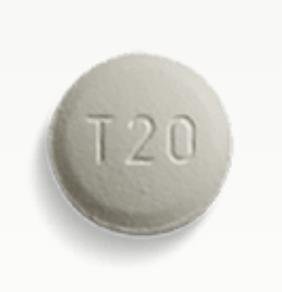Gilotrif Side Effects
Generic name: afatinib
Note: This document contains side effect information about afatinib. Some dosage forms listed on this page may not apply to the brand name Gilotrif.
Applies to afatinib: oral tablet.
Serious side effects of Gilotrif
Along with its needed effects, afatinib (the active ingredient contained in Gilotrif) may cause some unwanted effects. Although not all of these side effects may occur, if they do occur they may need medical attention.
Check with your doctor immediately if any of the following side effects occur while taking afatinib:
More common
- Bloody or cloudy urine
- burning, dry, or itching eyes
- diarrhea
- difficult, burning, or painful urination
- discharge or excessive tearing
- fever
- frequent urge to urinate
- redness, pain, or swelling of the eye, eyelid, or inner lining of the eyelid
- redness, swelling, or pain of the skin
- scaling of the skin on the hands and feet
- tingling of the hands and feet
- ulceration of the skin
Less common
- Cough
- difficult breathing
Rare
- Bloody, black, or tarry stools
- heartburn
- indigestion
- nausea
- severe abdominal pain, cramping, or burning
- vomiting of material that looks like coffee grounds, severe and continuing
Get emergency help immediately if any of the following symptoms of overdose occur while taking afatinib:
Symptoms of overdose
- Dizziness
- headache
- lack or loss of strength
- stomach pain
- vomiting
Other side effects of Gilotrif
Some side effects of afatinib may occur that usually do not need medical attention. These side effects may go away during treatment as your body adjusts to the medicine. Also, your health care professional may be able to tell you about ways to prevent or reduce some of these side effects.
Check with your health care professional if any of the following side effects continue or are bothersome or if you have any questions about them:
More common
- Blemishes on the skin
- canker sores
- chapped, red, or swollen lips
- decreased appetite
- decreased weight
- dry skin
- itching skin or rash
- loosening of the fingernails
- nosebleeds
- pimples
- redness or soreness around the fingernails
- runny nose
- scaling, redness, burning, pain, or other signs of inflammation of the lips
- sores, ulcers, or white spots on the lips or tongue or inside the mouth
For Healthcare Professionals
Applies to afatinib: oral tablet.
Gastrointestinal
Very common (10% or more): Diarrhea (96%), stomatitis (71%), cheilitis (12%), nausea, vomiting
Common (1% to 10%): Dyspepsia
Uncommon (0.1% to 1%): Pancreatitis[Ref]
Dermatologic
Very common (10% or more): Acneiform rash/dermatitis (90%), paronychia (58%), dry skin (31%), pruritus (21%), alopecia (13%)
Common (1% to 10%): Palmar-plantar erythrodysesthesia syndrome, nail disorders
Uncommon (0.1% to 1%): Bullous, blistering, and exfoliating lesions
Rare (0.01% to 0.1%): Stevens-Johnson syndrome, toxic epidermal necrolysis (TEN)[Ref]
Genitourinary
Very common (10% or more): Cystitis (13%)[Ref]
Hepatic
Very common (10% or more): Alanine aminotransferase increased (11%)
Common (1% to 10%): Aspartate aminotransferase increased[Ref]
Metabolic
Very common (10% or more): Decreased appetite (29%), weight decreased (17%)
Common (1% to 10%): Dehydration, hypokalemia[Ref]
Ocular
Very common (10% or more): Conjunctivitis (11%)
Common (1% to 10%): Dry eye
Uncommon (0.1% to 1%): Keratitis (e.g., acute or worsening eye inflammation, lacrimation, light sensitivity, blurred vision, eye pain, and/or red eye)[Ref]
Other
Very common (10% or more): Fatigue (19%), pyrexia (12%)[Ref]
Respiratory
Very common (10% or more): Epistaxis (17%), nasopharyngitis (14%), rhinorrhea (11%)
Uncommon (0.1% to 1%): Interstitial lung disease (ILD) or ILD-like adverse reactions (e.g., lung infiltration, pneumonitis, acute respiratory distress syndrome, alveolitis allergic)[Ref]
Musculoskeletal
Common (1% to 10%): Muscle spasm[Ref]
Psychiatric
Very common (10% or more): Insomnia (15%)[Ref]
Nervous system
Very common (10% or more): Headache (14%), dizziness (11%)
Common (1% to 10%): Dysgeusia[Ref]
Renal
Common (1% to 10%): Renal impairment/renal failure[Ref]
Frequently asked questions
- How long can I take Gilotrif (afatinib) for?
- Is Gilotrif (afatinib) a chemotherapy drug?
- How does Gilotrif (afatinib) work?
More about Gilotrif (afatinib)
- Check interactions
- Compare alternatives
- Pricing & coupons
- Reviews (1)
- Drug images
- Side effects
- Dosage information
- During pregnancy
- FDA approval history
- Drug class: multikinase inhibitors
- Breastfeeding
- En español
Patient resources
Professional resources
Related treatment guides
References
1. Cerner Multum, Inc. UK Summary of Product Characteristics.
2. Cerner Multum, Inc. Australian Product Information.
3. Product Information. Gilotrif (afatinib). Boehringer Ingelheim. 2013.
Further information
Always consult your healthcare provider to ensure the information displayed on this page applies to your personal circumstances.
Some side effects may not be reported. You may report them to the FDA.

